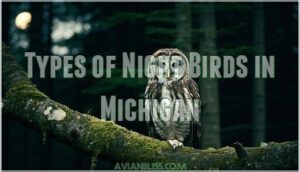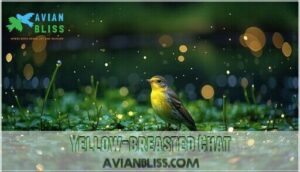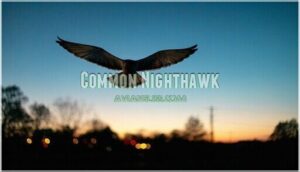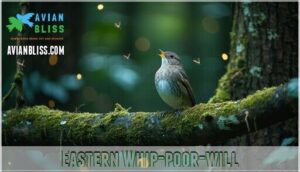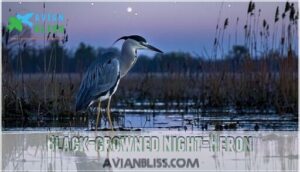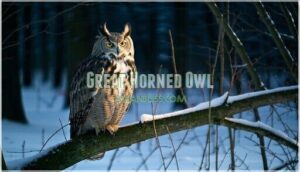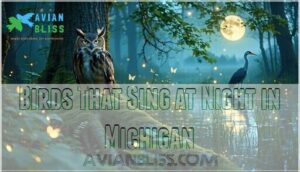This site is supported by our readers. We may earn a commission, at no cost to you, if you purchase through links.
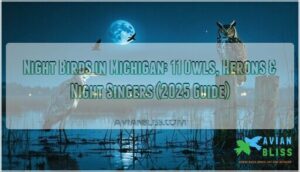
Great Horned Owls dominate with their deep hoots, while Barn Owls glide silently over farmland like pale ghosts.
Eastern Whip-poor-wills repeat their namesake call hundreds of times, and Common Nighthawks perform dramatic dives during summer evenings.
Black-crowned Night-Herons hunt wetlands after dark, joined by smaller Eastern Screech-Owls whose trills echo through neighborhoods.
Barred Owls deliver their famous "who-cooks-for-you" call, while Short-eared and Long-eared Owls patrol open grasslands and dense forests respectively.
Understanding their unique hunting patterns and preferred habitats reveals the secrets to spotting these nocturnal masters with their distinct calls and behaviors.
Table Of Contents
- Key Takeaways
- Types of Night Birds in Michigan
- Northern Mockingbird
- Yellow-breasted Chat
- Common Nighthawk
- Eastern Whip-poor-will
- Black-crowned Night-Heron
- Great Horned Owl
- Barn Owl
- Barred Owl
- Long-eared Owl
- Short-eared Owl
- Eastern Screech-Owl
- Birds That Sing at Night in Michigan
- Frequently Asked Questions (FAQs)
- What kind of birds come out at night?
- Why do I hear birds at 2am?
- Are there nightjars in Michigan?
- What kind of bird makes a lot of noise at night?
- When is the best time for night birding?
- What equipment helps identify nocturnal birds effectively?
- How do night birds navigate in darkness?
- Which Michigan habitats attract the most night birds?
- Do night birds migrate differently than daytime species?
- Conclusion
Key Takeaways
- You’ll discover eleven fascinating nocturnal species in Michigan, including Great Horned Owls with their deep hoots, Barn Owls gliding silently over farmland, and Eastern Whip-poor-wills repeating their namesake call hundreds of times throughout the night.
- You can identify these night birds by their distinctive calls and behaviors—listen for the Barred Owl’s famous "who-cooks-for-you" call, Northern Mockingbirds delivering midnight concerts, and Common Nighthawks performing dramatic diving displays with booming wing sounds.
- You’ll find the best night birding opportunities from sunset to midnight, focusing on diverse habitats like dense woodlands, wetland edges, and open grasslands where these species hunt for insects, small mammals, and fish using exceptional hearing and night vision.
- You’re witnessing birds that face serious conservation challenges from habitat loss and light pollution—supporting forest conservation, reducing pesticide use, and minimizing outdoor lighting during breeding season helps protect these remarkable nocturnal creatures for future generations.
Types of Night Birds in Michigan
Michigan’s night-shift workers include thirteen remarkable nocturnal species that transform your evening walks into acoustic adventures.
Discover the hidden symphony of Michigan’s darkness—where owls hoot, mockingbirds mimic, and night comes alive with wings.
You’ll discover diverse Michigan owl species like the Great Horned Owl and Barred Owl hunting through darkness, while night birds Michigan residents cherish fill forests with mysterious calls.
Nocturnal birding reveals fascinating avian ecology patterns you won’t see during daylight hours.
Migration patterns bring seasonal visitors like the Eastern Whip-poor-will, while year-round residents adapt to Michigan’s changing seasons.
These night birds occupy varied habitats from dense forests to urban parks, each species perfectly adapted to their nocturnal niche.
Barred owls thrive in mature forests, where they hunt small mammals.
Light pollution threatens these remarkable creatures, making habitat conservation efforts essential for their survival.
When you venture out after sunset, you’re witnessing millions of years of evolutionary adaptation.
From the haunting hoots of owls to the melodic trills of mockingbirds, Michigan’s night birds create a symphony that connects you to the wild heart of the Great Lakes region.
Northern Mockingbird
You’ll hear the Northern Mockingbird’s nocturnal singing long before you spot this talented Michigan birds performer.
This backyard bird delivers elaborate midnight concerts, with young males most active between midnight and 4 AM.
Found year-round in urban habitats and wooded areas, mockingbirds thrive where trees provide suitable perches for their vocal displays.
Their mockingbird diet includes insects they catch during nighttime hunts, making them valuable pest controllers.
For night bird identification Michigan enthusiasts, listen for their melodious whistling songs on moonlit evenings.
The conservation status remains stable, but protecting their preferred suburban and wooded night birds habitats guarantees future generations enjoy these musical performances.
They’re known to be remarkable mimics of other bird songs.
Yellow-breasted Chat
While mockingbirds belt out their melodies through midnight hours, another fascinating vocalist emerges in southern Michigan’s shrublands.
You’ll find the Yellowbreasted Chat hiding in dense thickets from May through August, though spotting one requires patience and keen observation skills.
This peculiar Michigan night birds species isn’t truly nocturnal—it’s crepuscular, meaning peak Chat Behavior occurs at dawn and dusk.
Here’s what makes these nocturnal birds special:
- Chat Habitat: Dense shrubby wetlands and forest edges provide perfect nesting grounds
- Chat Vocalizations: Eerie, jazz-like songs mixing whistles, cackles, and gurgles attract mates
- Chat Diet: Small insects like moths and beetles, plus wild berries during late summer
- Chat Conservation: Habitat loss threatens populations, making wetland protection essential
These chunky, warbler-sized Michigan birds demonstrate unique ground-scratching feeding behaviors while foraging through thick vegetation, making them true characters among night birds.
Female chats construct well-concealed nests in dense shrubs.
Common Nighthawk
During summer evenings, you’ll spot Common Nighthawks diving through Michigan’s twilight skies with their distinctive "peent" calls echoing across urban habitats.
Michigan’s twilight hunters put on a spectacular aerial show, complete with booming wings and haunting calls that echo through the darkness.
These nocturnal birds showcase remarkable camouflage during daylight hours, appearing as mottled bark on tree branches. Their erratic flight patterns and booming wing sounds create an unforgettable spectacle as they hunt insects with wide-open mouths.
One bird that also frequents backyards is the bright blue Blue Jay.
| Characteristic | Details |
|---|---|
| Flight Pattern | Erratic diving and soaring with distinctive wing booms |
| Feeding Behavior | Catches insects mid-flight with large mouth opening |
| Habitat Preference | Open woodlands, cities, and wetland edges |
Unfortunately, their conservation status shows concerning population declines. Supporting nighthawk migration corridors and protecting their breeding grounds helps guarantee these Michigan night birds continue thriving in our state’s diverse ecosystems.
Eastern Whip-poor-will
While Common Nighthawks patrol the skies at dusk, the Eastern Whippoorwill prefers staying closer to the ground.
You’ll find this nocturnal songbird in Michigan’s dry woodlands, where its camouflaged plumage blends perfectly with fallen leaves and bark.
The bird’s famous three-syllable call—"whip-poor-will"—echoes through the darkness, with males sometimes repeating it over 1,000 times without stopping.
These nocturnal birds face serious challenges.
Habitat loss has caused a 70% population decline since the 1960s, making conservation efforts critical for their survival.
As a species considered to be Near Threatened, conservation efforts are especially important.
Their insect diet depends on healthy forest ecosystems, and twilight activity patterns make them vulnerable to light pollution.
Michigan birds like the Eastern Whippoorwill need our help to survive:
- Support local forest conservation projects
- Reduce pesticide use in your yard
- Keep outdoor lighting minimal during breeding season
Black-crowned Night-Heron
While Eastern Whip-poor-wills serenade from forest floors, another nocturnal hunter patrols Michigan’s wetlands with silent precision.
The Black-crowned Night-Heron transforms from a hunched, cryptic bird by day into an active predator after sunset.
You’ll recognize this stocky heron by its distinctive black cap and back contrasting sharply with gray wings and white underparts. At 25 inches long and weighing nearly two pounds, these Michigan birds use their bright yellow eyes to spot prey in darkness.
Their diet analysis reveals they’re opportunistic feeders, catching fish, frogs, and small mammals with lightning-fast strikes. Their diet primarily consists of crustaceans and crabs.
| Characteristic | Details |
|---|---|
| Hunting Style | Motionless ambush predator |
| Peak Activity | Midnight to dawn hours |
| Migration Patterns | Nighttime travel to wintering grounds |
| Population Status | Recovering from DDT-era declines |
Habitat threats include wetland loss and building collisions during night flights.
Supporting wetland conservation and lights-out campaigns helps protect these remarkable nocturnal birds throughout Michigan’s diverse ecosystems.
Great Horned Owl
Perched silently in Michigan’s towering oaks, the Great Horned Owl reigns as the state’s most formidable nocturnal predator. You’ll recognize this Michigan owl by its distinctive ear tufts and piercing yellow eyes that can spot prey in near-total darkness.
Their soft feathers enable completely silent flight, making them deadly efficient hunters across diverse habitats from dense forests to suburban neighborhoods. These nocturnal birds Michigan residents often hear hooting possess remarkable hunting strategies and owl behavior that includes taking prey as large as skunks and house cats.
Their nesting habits involve claiming abandoned hawk nests or tree hollows, where they raise young as early as January. Great horned owls sometimes take over nests from other species.
Key features of Great Horned Owls:
- Wingspan reaches 3-5 feet with exceptional night vision
- Habitat needs include mature trees near water sources
- Conservation status remains stable despite urban pressures
- Michigan bird sounds night include deep, resonant "hoo-hoo-hoo" calls
Night birds like these magnificent owls demonstrate nature’s perfect adaptation to darkness.
Barn Owl
While Great Horned Owls dominate through size and power, Barn Owls rely on stealth and precision. You’ll recognize Michigan’s ghostly hunter by its distinctive heart-shaped facial disc and pale, buff-colored plumage.
These medium-sized owls prefer open agricultural landscapes, nesting in old barns, hollow trees, and specially placed nest boxes. Their silent flight is aided by specialized wing feathers.
| Feature | Description | Benefit |
|---|---|---|
| Heart-shaped face | Acts as sound funnel | Enhanced hearing precision |
| Silent flight | Specialized wing feathers | Undetected approach to prey |
| Pale coloration | Camouflage in moonlight | Reduced visibility to prey |
| Long legs | Sparsely feathered | Better ground hunting ability |
| Dark eyes | Adapted for night vision | Superior nocturnal hunting |
Barn Owl habitat requirements include open grasslands, agricultural fields, and marshy areas where small mammals thrive. Their hunting strategies involve flying low over fields, using exceptional hearing to locate rodents.
Conservation status remains stable thanks to nest box programs supporting their nesting habits throughout Michigan’s nocturnal wildlife communities.
Barred Owl
You’ll recognize the Barred Owl by its distinctive "who-cooks-for-you" call echoing through Michigan’s mixed forests.
These medium-sized owls with brown and white barred plumbing prefer mature woodlands near water sources, particularly areas with hemlock and maple trees.
Barred Owl Diet consists primarily of small mammals, amphibians, and fish caught during nighttime hunts.
Their Habitat Preference centers on extensive deciduous forests—about 9,300 hectares support roughly three breeding pairs.
Vocalizations include their famous hooting sequence, which intensifies during Mating Rituals from February through April.
Barred owl Michigan populations nest in tree cavities, with 74.8% choosing natural hollows.
Their Conservation Status remains stable, though they depend on old-growth forests.
Like the barn owl, barred owls also have distinctive facial discs that aid in hunting.
These Michigan owls represent important nocturnal wildlife, contributing to the state’s diverse night birds Michigan community.
Listen for their owl calls Michigan at dusk near swampy woodlands.
Long-eared Owl
Hidden among Michigan’s dense woodlands, the Long-eared Owl presents one of the state’s most elusive nocturnal hunters.
You’ll recognize this medium-sized owl by its prominent ear tufts and exceptional camouflage abilities that make it nearly invisible against tree bark.
Long-eared habitat includes small woodlots adjacent to grasslands, where these Michigan owls roost in dense vegetation during daylight hours.
Their owl diet consists almost entirely of small rodents, particularly voles, making them specialized predators in Michigan’s nocturnal wildlife community.
Listen for their soft "hoo-hoo-hoo" calls starting an hour before darkness falls.
These night birds Michigan residents rarely see hunt silently over open fields, using incredible hearing to locate prey.
The similar Short-eared Owl also thrives in open areas, exhibiting diurnal hunting behavior.
Regarding nesting habits, they occupy abandoned crow or hawk nests in conifers.
Their conservation status remains stable, though habitat fragmentation poses ongoing challenges.
When observing these remarkable owl species, maintain respectful distances and avoid bright lights that disrupt their natural hunting patterns.
Short-eared Owl
Despite their widespread range across three continents, Short-eared Owls remain elusive treasures in Michigan’s nocturnal wildlife scene.
You’ll spot these magnificent night birds of prey Michigan offers during winter months, when they hunt over open grasslands and prairies at dusk. Their buoyant flight and cat-like facial disc make them unmistakable against twilight skies.
Here’s what makes them special:
- Habitat Preferences: Open fields, grasslands, and agricultural areas where voles thrive
- Hunting Strategies: Low, coursing flight patterns with occasional hovering over prey
- Owl Migration: Winter visitors that arrive from northern breeding grounds
- Conservation Status: Stable populations but vulnerable to habitat loss
Michigan bird watching night enthusiasts should focus on expansive farmland during late afternoon.
These Shorteared Owl visitors support Michigan ecosystems through effective rodent control, though Population Threats from development continue challenging their survival.
Their bright yellow eyes are a distinctive feature.
Eastern Screech-Owl
The Eastern Screech-Owl calls from tree cavities throughout central and eastern Michigan, making it a standout in any Michigan night bird guide. This compact nocturnal hunter perfectly demonstrates Screech-Owl Behavior through its stealthy nighttime activities across diverse Screech-Owl Habitat from woodlands to suburban areas.
You’ll recognize Screech-Owl Sounds by their distinctive whinnying call that resembles a horse’s neigh. Their Screech-Owl Diet consists of small mammals, insects, and birds, which they swallow whole before regurgitating pellets containing bones and fur. These Michigan nocturnal wildlife specialists roost in tree cavities during daylight hours, staying hidden from predators.
Their western counterparts exhibit varied vocalizations as well. Here’s what makes screech owl Michigan encounters memorable:
- Their yellow eyes glow like tiny headlights in your flashlight beam
- They’re masters of camouflage, blending seamlessly into bark patterns
- You can attract them using nest boxes mounted 10-15 feet high
- Their calls echo through quiet woods on still evenings
Supporting Screech-Owl Conservation means protecting mature trees that provide essential nesting sites for these remarkable Night birds Michigan residents.
Birds That Sing at Night in Michigan
Several Michigan night birds create enchanting nocturnal birdsongs that transform darkness into nature’s concert hall. You’ll hear Northern Mockingbirds delivering complex melodies between midnight and 4 AM, especially young males seeking mates.
Their avian vocalization includes mimicked sounds from other species, making song identification both challenging and rewarding. Eastern Whip-poor-wills contribute their famous three-syllable calls during summer breeding season, while Yellow-breasted Chats offer eerie, variable songs at dawn and dusk.
Great Horned Owls provide deep hoots, and Barred Owls deliver their distinctive "who-cooks-for-you" calls. This singing behavior serves vital purposes—territory defense, mate attraction, and communication.
Unfortunately, habitat loss threatens these Michigan night birds, creating significant conservation impact. Supplementing their diet with native plant selection can help support local bird populations.
When you’re exploring Michigan bird sounds after dark, remember that protecting woodlands and wetlands guarantees future generations can enjoy these remarkable bird calls that make Michigan’s nights truly magical.
Frequently Asked Questions (FAQs)
What kind of birds come out at night?
You’ll encounter owls, nightjars, and herons when darkness falls.
These nocturnal hunters use exceptional hearing and night vision to catch prey while most birds sleep, filling the night with distinctive calls and songs.
Why do I hear birds at 2am?
You’re hearing nocturnal birds like mockingbirds, whip-poor-wills, or owls.
You’re experiencing their natural activity patterns.
You’re listening to territorial calls, mate attraction songs, or hunting sounds that peak during Michigan’s quiet nighttime hours.
Are there nightjars in Michigan?
Yes, you’ll find nightjars in Michigan.
The Eastern Whip-poor-will and Common Nighthawk both call Michigan home during breeding season.
You’ll hear their distinctive calls echoing through forests and open areas on warm summer nights.
What kind of bird makes a lot of noise at night?
Like nature’s midnight orchestra conductor, you’ll most likely hear Northern Mockingbirds creating their symphony. These talented mimics sing elaborate songs between midnight and 4 AM, especially young males seeking mates.
When is the best time for night birding?
The prime window for night birding spans from sunset to midnight, with peak activity occurring during the first two hours after dark.
Dawn’s early hours also offer excellent opportunities when nocturnal species remain active, making it a great time for night birding.
What equipment helps identify nocturnal birds effectively?
You’ll need binoculars with excellent low-light performance, a red-filtered flashlight to preserve night vision, and a reliable field guide or birding app.
Consider bringing a portable speaker for playback calls to attract curious nocturnal species.
How do night birds navigate in darkness?
Night birds use exceptional hearing to detect prey rustling and calls echoing through darkness.
You’ll find they rely on silent flight feathers, keen eyesight adapted for low light, and specialized inner ear structures for precise navigation.
Which Michigan habitats attract the most night birds?
Forests whisper secrets to nocturnal hunters—you’ll find most night birds in Michigan’s dense woodlands, wetland edges, and shrubby thickets.
These diverse habitats provide perfect cover, abundant insects, and safe nesting sites for owls, nightjars, and herons, making them ideal for nocturnal hunters.
Do night birds migrate differently than daytime species?
Yes, you’ll find night birds often migrate differently than daytime species.
They’re built for darkness travel, using stars for navigation and flying longer distances nonstop, while day birds rely more on landmarks.
Conclusion
Michigan’s nocturnal symphony awaits your discovery, like a hidden orchestra tuning up after sunset.
These night birds in Michigan transform darkness into opportunity, each species playing its essential role in nature’s evening performance.
You’ll find success by learning their calls, understanding their habitats, and timing your observations correctly, whether you’re tracking the Great Horned Owl’s territorial hoots or listening for the Whip-poor-will’s persistent chorus.
Patience and preparation will reward you with unforgettable encounters with these remarkable nocturnal creatures, and unforgettable encounters will be the result of your efforts.

